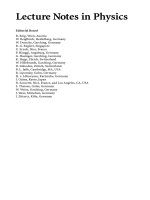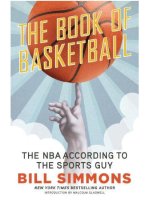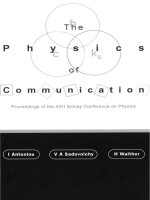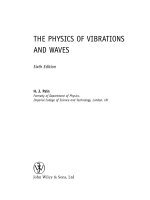The physics of basketball john j fontanella
Bạn đang xem bản rút gọn của tài liệu. Xem và tải ngay bản đầy đủ của tài liệu tại đây (2.61 MB, 168 trang )
The Physics of Basketball
This page intentionally left blank
The Physics of
BASKETBALL
John J. Fontanella
The Johns Hopkins University Press
Baltimore
© 2006 The Johns Hopkins University Press
All rights reserved. Published 2006
Printed in the United States of America on acid-free paper
9 8 7 6 5 4 3 2 1
The Johns Hopkins University Press
2715 North Charles Street
Baltimore, Maryland 21218-4363
www.press.jhu.edu
Library of Congress Cataloging-in-Publication Data
Fontanella, John (John J.), 1945–
The physics of basketball / John J. Fontanella.
p. cm.
Includes bibliographical references and index.
ISBN 0-8018-8513-2 (hardcover : acid-free paper)
1. Physics. 2. Basketball. 3. Force and energy. 4. Human mechanics. I. Title.
QC26.F66 2007
796.32301´53—dc22 2006010575
A catalog record for this book is available from the British Library.
Preface vii
Acknowledgments xiii
Chapter 1 The Final Four 1
Chapter 2 Projectile Notion 19
Chapter 3 Nothing But Net 35
Chapter 4 Basket Case 69
Chapter 5 That’s the Way the Ball Bounces 97
Chapter 6 Hang Time 121
Appendixes 133
I. The Drag Force
II. The Magnus Force
III. Trajectory Calculations
IV. Calculation Setup
V. Bounce Angles
VI. Coefficient of Restitution
Notes
141
Index 145
Contents
This page intentionally left blank
My brother will confirm that I began talking about writing a book on bas-
ketball and physics 40 years ago. I thought about it for 39.5 years, then
started. I’m still not sure why I started even then. It might have been because
of what I heard at some of the sessions on “Physics of Sports and the
Human Body” during the 2004 Summer Meeting of the American
Association of Physics Teachers. Maybe it was because of the U.S. basket-
ball debacle at the 2004 Summer Olympics. Some of what I saw and heard
made me think that I might have something useful to say about the game.
I was lucky enough to have had three outstanding coaches in my bas-
ketball career. My coach from grade school through sophomore year at
Wampum High School, L. Butler Hennon, won 12 straight Section 20
Championships and 3 Class B State Championships and is a legend in
western Pennsylvania. I was the starting point guard on the twelfth sec-
tion championship team. Wampum High School was broken up after the
1961 season and I was sent to Mohawk High School, where John Samsa
was coach. He was an excellent game coach. My coach at Westminster
College, C. G. “Buzz” Ridl, was 1962 Coach of the Year of the National
Association of Intercollegiate Athletics. He was 1974 Coach of the Year of
the National Collegiate Athletic Association in the East while at the
University of Pittsburgh. Presumably, Pitt grew tired of losing to teams
coached by Buzz Ridl, so they hired him after the 1968 season.
vii
Preface
As I began to think about some of their teachings from a physics point
of view, it became clear why what they taught was correct. It also became
clear that some of those lessons had been forgotten. There is also the mat-
ter of timing. I was fortunate enough to have been granted a sabbatical by
the United States Naval Academy. Still another possible reason I started
the book is that I’ve recently become enthusiastic about making physics
relevant. Whatever the reason or reasons, this book represents my attempt
to say a few words about some things that I love at a level exceeded only
by my love for my family.
My hometown, Wampum, is a small town in western Pennsylvania.
Even though western Pennsylvania is well known these days for football
and football quarterbacks in particular, basketball was at least as impor-
tant in the fifties and sixties. I grew up surrounded by athletes who
became famous in other sports and who honed their skills via basketball.
For example, I remember playing basketball against Joe Namath in 1961.
It was a scrimmage between Wampum and his high school, Beaver Falls,
which is about 10 km (6 miles) from my home. The list of my childhood
heroes, all of whom grew up within about 30 km (20 miles) of my home
includes Mike Ditka, Tito Francona (Terry’s dad), Chuck Tanner, and
Mike Lucci. About as close as we came to basketball fame is that Pistol
Pete Maravich was born in the town where Mike Ditka grew up. Pete and
his dad were legends in western Pennsylvania, but I didn’t know until
researching this book that he moved away when he was very young.
Nice discussions of some of the local sports figures of that era can be
found in the books by Bob Vosburg, Scooter’s Days… and Other Days (New
Wilmington, PA, 1997) and This Man’s Castle (New Wilmington, PA, 2005).
Wampum is famous as the home of the Allen brothers, Coy, Caesar,
Hank, Dick, and Ron. Hank, Dick, and Ron spent a total of 40 years play-
ing professional baseball. The best known is Dick Allen who was Rookie
of the Year in the National League in 1964 and Most Valuable Player of
the American League in 1972. What he endured during his baseball career,
as described in his autobiography, Crash: The Life and Times of Dick Allen,
by Dick Allen and Tim Whitaker (New York, 1989), makes me doubly
viii Preface
proud to have known him. My most vivid memory of Dick Allen is what
he did during a basketball game at New Wilmington High School in 1960.
I was a freshman sitting in the stands having just finished playing in the
Junior Varsity game. I remember someone throwing a ball from about half
court that was headed for a point about halfway up the backboard on the
right. He jumped up to meet the ball then guided it down through the
hoop. It was then that I knew that I would be playing the game just for
fun. I was closest to his brother Ron who was the star on our twelfth sec-
tion championship team.
I started college in 1963 in New Wilmington, another small town in
the same county as Wampum. In 1962 Westminster had been named the
top small college basketball team in the nation by both the Associated
Press and the United Press International. One of the stars of that team,
Ron Galbreath, was from Wampum. Ron became a college coach and was
10 wins away from 600 as of the writing of this book. Also, my neighbor,
Mike Swanik, had been an outstanding contributor to another West-
minster team, and thus going to school there seemed the obvious thing to
do. Playing at a college close to home gave my parents and my uncle,
Joseph Mikita, the opportunity to attend all of my home games and most
of the away games. It made the successes more satisfying and the failures
less painful.
Things were different then. The distinction between the basketball
teams from small and large colleges wasn’t quite so pronounced as it is
today. Very early on there was no difference. For example, according to
Madison Square Garden by Zander Hollander (New York, 1973) and The
Story of Basketball by Lamont Buchanan (New York, 1948), on December
29, 1934, Westminster defeated St. John’s 37–33 during the first basketball
doubleheader played at Madison Square Garden. That tradition continued
through when I played. I took great pleasure in beating Pitt during both
my junior and senior years. The win over Pitt during my junior year
alerted Syracuse that we were a decent team so they were ready for us
when we visited there to end the season. We were beaten badly, but the
game almost gave me a claim to fame since I outscored Dave Bing 24 to
Preface ix
22. I say “almost” because Bing left at half-time to play in an All-Star game.
Jim Boeheim, the current coach at Syracuse, had 13 points in the game for
Syracuse. A book has recently appeared describing those times, The Glory
Days by Dick Minteer (Westminster College, 2004). For Westminster, that
era ended in 1969 which was the last year that they defeated a Division I
school.
I must admit that the transition from basketball player to physicist was
difficult. It was my own fault. I had spent huge amounts of time playing
basketball. I must have been trying to evaluate one of the statements that
I recently noticed in Bob Vosburg’s first book: “Hard work will beat talent
if talent doesn’t work hard.” Fortunately, the people at Case were patient
and understanding. Thanks to them and further testing of the quote from
Vosburg’s book, I’ve been able to spend an enjoyable career teaching and
doing research at the Naval Academy.
By now I’ve spent a lot more time teaching and doing physics than play-
ing basketball. Consequently, the book draws on extensive time spent in
both the scientific and athletic communities. This duality makes it difficult
to categorize the book. One possibility is that the book is basketball from
a physics point of view. Another is that it is physics from a basketball point
of view. I like to think that it’s both. On the basketball side, I wanted to say
some things that might give a basketball player an edge. Even a rudimen-
tary understanding of what is possible and what is not can significantly
streamline and accelerate learning the game. The need for this has taken on
increased importance in today’s world of video games and movies where
reality is often not on display. It is also possible that an advanced understand-
ing of the underlying physics can help distinguish between subtle differ-
ences in technique. The other part of what I wanted to say has to do with
the physics itself. I wanted to communicate some of the physics in action
I now see in the game of basketball. I hope that there is some information
in the book that physics teachers can use in the classroom.
Though it is difficult to say what the book is, it is clear what the book
is not. It isn’t a novel. While sections of the book should be pleasant read-
ing, a large fraction of the book is technical. It describes the hows and whys
x Preface
of basketball and uses physics to distinguish good technique from bad.
Further, there is no attempt to show how to teach the techniques that are
identified in the book as best. I tried some coaching of my son’s and daugh-
ter’s basketball and baseball or softball teams. It quickly became obvious
that I should not quit my day job to become a coach. Because of those expe-
riences, there is no advice in the book on how to coach. Fortunately, there
are some excellent books on coaching. One of the best is the book by
Morgan Wootten, Coaching Basketball Successfully (Champaign, IL, 2003).
Because of that book, and because I have finally gotten around to think-
ing through the game, it might be fun to try coaching again.
Finally, because of the work that went into this book, I watch basket-
ball games differently now. Who does what and the flow of the game are
still the focus. However, I find myself thinking more about how players
do what they do and evaluating how well they do it. The flight, spin, and
bounce of the ball and the motion of the players and the interactions that
they cause or experience have all become more important. I enjoy watch-
ing the game more now though I’d still rather be a doer than a viewer. My
final hope, then, is that some of the insights contained in the book will
deepen the appreciation of the game for the serious fan.
Preface xi
This page intentionally left blank
Writing this book has been a family effort. My wife, Dr. Mary Wintersgill, is
a physicist and is currently chair of the physics department at the United
States Naval Academy. She has been a great help with all aspects of the book.
My son has just entered seminary. He must have contributed since it’s clear
that the book has made it into print only because of divine intervention. My
daughter is an English major and physics minor at college and made exten-
sive suggestions for improving all of the chapters. In fact, all three family
members suffered through innumerable versions of the manuscript.
Special thanks go to Mrs. Betty Ridl for providing a great deal of use-
ful information. In addition to her many activities at Westminster College
and the University of Pittsburgh, Mrs. Ridl serves on the Advisory Board
for Coaches vs. Cancer. Joe Onderko, the sports information director at
Westminster, excavated some ancient statistics for me. I also thank my
many teammates. What I didn’t learn from my wonderful coaches, I
learned from them. My contact for basketball at USNA has been Dave
Smalley. During his career he successfully coached the men and started
the women’s program. Dave has a great deal in common with my college
coach. They are examples of masters and gentlemen of the game. Many
others have recognized that. The gym at Westminster is known as Buzz
Ridl Gymnasium and the varsity basketball court at the Naval Academy
is named Dave Smalley Court.
xiii
Acknowledgments
I am indebted to my undergraduate school, Westminster College (New
Wilmington, Pa.), for providing an atmosphere where an athlete can also be
a student. I am also indebted to my graduate school, Case, for providing an
opportunity for someone who was initially more athlete than student. My
thesis advisor at Case, Donald E. Schuele, has had a lifelong interest in sports.
I met Don on the basketball court during a noontime pickup game and we
played basketball, softball, and volleyball together in various leagues. Don
served on the Science and Engineering Technology Committee of the U.S.
Olympic Committee for 10 years.
I have been fortunate to have had a succession of outstanding research
collaborators: Dr. Carl G. Andeen of Andeen-Hagerling, Inc., Dr. Alan V.
Chadwick of the University of Kent at Canterbury (U.K.), Dr. Steven G.
Greenbaum of Hunter College of CUNY, John T. Bendler, Donald J. Treacy,
and Charles A. Edmondson of the USNA Physics Department, and Michael F.
Shlesinger of the U.S. Office of Naval Research. I have learned a lot about
science from them. Thanks also go to Kevin Sinnett of USNA for providing
me with a list of his favorite moments in basketball history. For comment-
ing on various parts of the manuscript I am grateful to Larry Ondako, the
men’s basketball coach at Westminster; Ron Galbreath, the women’s coach
at Geneva College; Dave Beam of Beam & Associates; and Don Schuele,
John Bendler, Mike Shlesinger, and Frank Gomba. I also thank Dave Rector
of USNA for arranging for me to use the LoggerPro
®
software, Vernier force
plate
®
, and a LabPro
®
data acquisition device. Finally, I am indebted to
Trevor Lipscombe, editor-in-chief of the Johns Hopkins University Press, for
his interest in the book. Trevor made several very helpful suggestions during
the preparation of the manuscript.
xiv Acknowledgments
The Physics of Basketball
This page intentionally left blank
Physics: It’s better than you think. It has to be. That sentiment was bor-
rowed from the Baltimore Opera Company. It’s what they say about opera
in their TV and radio commercials. I suppose that writing about opera and
physics is not a good way to begin a book. I would like more than five peo-
ple to read it.
1
However, opera definitely belongs in a book about basket-
ball since one of the great sports quotes of all time, “The opera ain’t over
until the fat lady sings,” became famous because of a basketball game.
2
Besides, physics and opera have a lot in common. They are both about
truth and beauty. That’s what this book is all about—truth and beauty in
the game of basketball. Let’s get started.
All aspects of the game of basketball are controlled by forces. Without
forces, a basketball or a basketball player would always move in a straight
line with a constant speed. A special constant speed is zero. In that case,
the basketball or basketball player would always be at rest. These are con-
sequences of an important law of physics, Newton’s First Law (N1L).
Needless to say, without forces there would be no game, so we’ll start
with a general discussion of forces and what they do. If you already know
a lot about forces, at least those usually presented in a typical general
physics course, you might consider skipping to the last section of this
chapter, “A Little Different Spin on Things.”
One
The Final Four
There’s a lot of insight into the nature of forces that can be gained
from these common sentences or phrases: “may the force be with you,”
“it was a force-out at second base,” “police force,” and “she was a force
in the senate.” Each of the examples hints at the scientific definition of
force, since each indicates that a force is involved when one thing “influ-
ences” another. The first thing that we must decide is what a force is. It
turns out that we can describe the game of basketball by defining a force
to be a push or a pull. Although basketball is not usually thought of as a
game of contact, pushes and pulls (forces) by one player on another are
part of the game. The pick and roll is not something that you have for
breakfast. I’ve seen some violent collisions happen during a pick. The idea
is to get in the way of someone trying to guard a teammate. Picks are
most effective when the person on defense is not aware that it’s going to
happen. The rules make the violence worse since the person setting the
pick must be firmly in place.
Some players go beyond the acceptable pushes and pulls. The most
notorious “bad boy” was Bill Laimbeer who is now coach of the 2003
Women’s National Basketball Association champion Detroit Shock.
Laimbeer played for the Detroit Pistons for most of his 15-year career that
began in 1980. Laimbeer was well known for his use of “unauthorized
force.” Before Laimbeer it was Norm Van Lier who played with the Chicago
Bulls for several years during the seventies. I can attest to Van Lier’s “aggres-
siveness.” We played against Van Lier because his college, Saint Francis
University (Pa.), was in Westminster’s conference. I remember being to the
right of the foul line during a game in February 1967 when I looked up and
saw Van Lier coming at me with a menacing look and his fist up. Now,
because of basketball, I’ve been pushed, elbowed, and defeated, but I’ve
never been intimidated. I smiled, bent over a bit, and drove my bony right
shoulder into his gut. I straightened up a bit and Van Lier became a quick
study in projectile motion. He didn’t bother me again.
Getting back to the physics, one of the forces that physicists talk about
is the force of gravity. The phrases “pull of gravity” or “gravitational pull”
are familiar and are consistent with our definition of a force. Other exam-
2 The Physics of Basketball
ples are “push a car” (I drive old British sports cars so I do that a lot), “pull
a wagon,” or the “pushing” violation (foul) in basketball.
The next thing that we need to decide is what a force does. We already
know that without forces a basketball or a basketball player would always
move in a straight line with a constant speed. A physicist would say that if
something moves in a straight line with a constant speed it has a constant
velocity. It follows that what a force does is change the velocity of a basket-
ball or basketball player. This is a case of cause and effect. It is reasonable to
say that a force is a cause and a change in velocity is an effect. This makes
clear the role of forces in the game of basketball. Both the ball and (a good)
player are perpetually changing direction and/or speed and the only way
that that can happen is via forces.
Physicists have a name for what happens when the velocity changes
and that is acceleration. Acceleration occurs when there is a change in either
the speed or direction of travel of a moving object. Both could change
simultaneously. Just as velocity tells us how fast the position changes, the
acceleration tells us how fast the velocity is changing. (A physicist would
define velocity as the rate of change of position and would define the
acceleration as the rate of change of velocity.) A familiar example is an air-
plane accelerating down the runway during takeoff. It is accelerating
because it is speeding up. (Note: If we are sitting in an airplane seat dur-
ing takeoff, what we feel is the force of the seat pushing us in the forward
direction. The acceleration is the rate change of velocity. Once the distinc-
tion between force and acceleration becomes clear, many of the myster-
ies of classical physics, at least, disappear.) The best way to observe accel-
eration is to watch a video of Michael Jordan, arguably the best basketball
player ever. Jordan played for the Chicago Bulls from 1984 to 1998 then
finished his career with the Washington Wizards during the 2002 and 2003
seasons. What MJ did best was accelerate. In my opinion, his ability to
change direction and change speed was unsurpassed.
To describe what made MJ play and to describe the physics of basket-
ball in general, we need to define one more quantity, mass. Mass is the
amount of matter that an object possesses. For example, 2.16 m (7´1´´ ) tall
The Final Four 3
Shaquille O’Neal, currently playing for the Miami Heat, has more mass,
148 kilograms (10.2 slugs) than 1.6 m (5´3´´ ) tall Tyrone “Muggsy” Bogues,
63.2 kilograms (4.4 slugs). Muggsy played college basketball at Wake
Forest University and is the shortest player ever to play in the National
Basketball Association. He had a 14-year NBA career including nine-plus
years as a Charlotte Hornet and is currently the coach of the WNBA
Charlotte Sting. Since they are made up of the same kind of stuff, Shaq
has more mass than Muggsy because there is more of Shaq.
What mass does is oppose acceleration. A force on something with a
large mass will result in a smaller acceleration than if the same force acts
on a smaller mass. This makes sense since a force on Shaq will have much
less effect (cause much less acceleration) than the same force on Muggsy.
The relationship between force, mass, and acceleration is the essence
of another important law of physics, Newton’s Second Law (N2L). The
usual statement of N2L is that the total (net) force on an object equals the
product of the mass times the acceleration of the object. More than one
force can act on an object (e.g., Shaq, Muggsy, or MJ) at the same time.
Those forces can be added so long as we are careful to include both the
strength (magnitude) and direction of the forces. The total (net) force is
just the sum of the forces.
It’s time for our first equation. Suppose that we represent the forces
on an object by F
1
, F
2
, and so on. The boldface indicates that a force has
both strength and direction. A physicist or mathematician would call
F
gravity
a vector. If m is the mass of the object and a is the object’s accel-
eration, Newton’s Second Law is usually written as
F
1
+ F
2
+ . . . = ma. (1.1)
This implies in symbols what we said in words. For a given set of forces,
F
1
+ F
2
+ . . . , if the mass is small, a is large and vice versa. It is easier to
accelerate Muggsy than it is to accelerate Shaq.
Equation (1.1) is not the way N2L was originally stated by Newton. It is
a special case that only applies to situations where the mass is not changing.
4 The Physics of Basketball
For example, it is not useful for rockets where the mass decreases as the fuel
is burned. However, equation (1.1) works just fine for our purposes. It accu-
rately describes the relationship between forces and accelerations for basket-
balls and players relative to a basketball court on the surface of the Earth.
There is often a lot of nonsense associated with discussions of N2L.
Force is often confused with acceleration. Part of the reason is that it is
sometimes said that “Force is mass times acceleration.” That is totally
bogus. N2L says that force is mathematically equal to the mass times the
acceleration. However, force is something different from acceleration and
mass is something different from both force and acceleration.
The Gravity of the Matter
Let’s consider a falling basketball in some detail. The most important force
on a basketball falling at a speed typical of those in a game is the force of
gravity. Gravity is the force by which masses attract one another. Gravity is
a fundamental force. It cannot be broken down into other forces. None of
the other forces described in this book are fundamental forces. The gravita-
tional force is sometimes known as the weight. On the surface of the Earth,
the gravitational force on Shaq is 1,450 newtons (325 pounds) and the grav-
itational force on Muggsy is 619 newtons (141 pounds). If we ever get to play
basketball on the Moon, our weight there will be a lot less, for the Moon’s
gravitational pull is only about a sixth of the Earth’s.
Unfortunately, confusion is often produced by the phrases “gravita-
tional acceleration” or “acceleration of gravity.” It is important to realize
that an object has “gravitational acceleration” if the velocity of the object
is changing only because of the force of gravity. That happens if gravity is
the only force that acts on the object. However, the force of gravity acts on
an object near the Earth whether or not it is accelerating. Consider a bas-
ketball sitting on the floor. Gravity, the force, still acts on the ball, yet there
is no acceleration because the velocity is not changing. The reason that the
acceleration is zero is that the total (net) force on the ball is zero. The total
(net) force on the ball is zero because, in addition to the downward force
of gravity, there is an upward force on the ball when it is sitting on the floor,
The Final Four 5
the force of the floor on the ball. The force of the floor on the ball is equal
and opposite to the downward force of gravity.
Beware—that the downward force of gravity is equal and opposite to
the upward force of the floor on the ball is not a consequence of Newton’s
Third Law (N3L). The usual (and misleading or incomplete) statement of
N3L is for every action there’s an equal and opposite reaction. What is usu-
ally missing is that the action and reaction forces must act on different objects.
The reason that the force of gravity and the force of the floor are not action
and reaction forces is that they both act on the basketball.
3
If we think of
both of those forces as action forces, there are two other (reaction) forces
that act on something else. They are easy to find. Consider the gravitational
pull of the Earth (down) on the ball. The corresponding reaction force is the
gravitational pull (up) of the ball on the Earth. That sounds strange since it
is unsettling to think that the ball pulls on the Earth. What is also strange but
true and a consequence of N3L is that if Shaq runs into Muggsy, the force of
Muggsy on Shaq is equal (and opposite) to the force that Shaq exerts on
Muggsy. Getting back to the basketball, the reaction force to the force of the
floor on the ball (up) is the force of the ball on the floor (down).
Sorry about the detour. Let’s get back to the effect of gravity on the
basketball. We will represent the force of gravity on the ball by an arrow
and label it F
gravity
. The force of gravity on a basketball near the surface
of the Earth is shown in figure 1.1.
6 The Physics of Basketball
Figure 1.1. The forces on a falling, spinning basketball in air near the surface of the Earth
F
gr a v ity
F
drag
Ea rt h
F
ma g n us
Spi n
F
buoy
Velo city
The direction of the force of gravity on the ball is downward since the
Earth pulls the basketball downward. When drawing vectors, I like to put
the tail of the arrow at the point where the force is applied. That would
make the vector appear to originate where the force is applied or appears
to be applied. The tail of the arrow F
gravity
is drawn at the center of the
basketball in figure 1.1 since that’s close to where the total (net) gravita-
tional force on the ball appears to act, the so-called center of gravity. As
we’ll see, sometimes it’s not convenient to draw the tail of the arrow at
the origin of the force.
The strength of the force of gravity on the ball is also known as the weight
of the ball, so we know that the strength of the force of gravity on a basket-
ball near the surface of the Earth is about 6 newtons (1.3 pounds). The strength
of the force of gravity (weight) on an object can be predicted using Newton’s
Law of Universal Gravitation. That law gives the following equation for the
strength of the force of gravity on a basketball near the surface of the Earth.
F
gravity
=
Gm
basketball
m
Earth
R
2
Earth
G is a universal constant (6.67x 10
–11
newton meter
2
per kilogram
2
),
m
basketball
is the mass of the basketball, m
Earth
is the mass of the Earth and
R
Earth
is the radius of the Earth. We are assuming that the basketball is a
distance R
Earth
from the center of the Earth. Equation (1.2) can always be
used to calculate the force of gravity. Plugging values for G, and the mass
and radius of the Earth into equation (1.2), we get F
gravity
= m
basketball
times
9.8 meters per second
2
(= m
basketball
times 32 feet per second
2
). For most of
the remainder of the book, I’ll use m for meters, ft for feet, in for inches,
s for seconds, N for newtons, lbs for pounds, and kg for kilograms.
Notations such as meters per second
2
will be written as m/s
2
though miles
per hour will be written as mph.
Confusion arises because 9.8 m/s
2
has units of acceleration and is
often referred to by the symbol g (g =Gm
Earth
/R
2
Earth
) and the names “grav-
itational acceleration” or “acceleration of gravity.” However, the way that
The Final Four 7
(1.2)
we have used it so far, 9.8 m/s
2
is not acceleration. It is just a number that
we can multiply mass by to get the force of gravity (weight). For example,
equation (1.2) is usually rewritten as
F
gravity
= m
basketball
g
As has been mentioned, there is one special case where 9.8 m/s
2
is an
acceleration. That special case is when gravity is the only force on an
object near the surface of the Earth. Since the force of gravity is propor-
tional to the mass of the object, the acceleration does not depend on the
mass of what is falling. This implies that the acceleration of either a men’s
or a women’s basketball falling under the influence of only gravity would
be 9.8 m/s
2
. That would be the case if a basketball were falling in a vac-
uum and would happen if the Earth had no atmosphere or air.
If a falling basketball had an acceleration of 9.8 m/s
2
it would be
speeding up 9.8 m/s every second. For example, a basketball starting from
rest would have a speed of 9.8 m/s after one second, 19.6 m/s after two
seconds, and so on. Where the basketball is located during the fall is
slightly more complicated. Since the ball speeds up as it falls, the distance
that it travels in equal time intervals increases as time passes. For exam-
ple, during the first second, the ball falls 4.9 m (16 ft), during the second
second it falls 14.7 m (48 ft), and so on.
By the way, if you are in the mood sometime to really annoy some-
one, ask a physicist what causes gravity and how gravity can pull on an
object when the object is in the air. My suggestion is that you do not lis-
ten too closely to the answer if it’s anything other than “We’re not really
sure but here are a few ideas . . .”
This has been a long discussion of gravity, partly as a warmup and
partly because gravity is the dominant force on a ball (or player) in flight
at the usual speeds associated with a typical basketball game. Since grav-
ity is the main factor influencing a shot, passed basketball, or an airborne
player, it can be said that the ability of players to deal with gravity is the
main factor that determines their level of success. We focus mostly on
8 The Physics of Basketball
(1.3)









